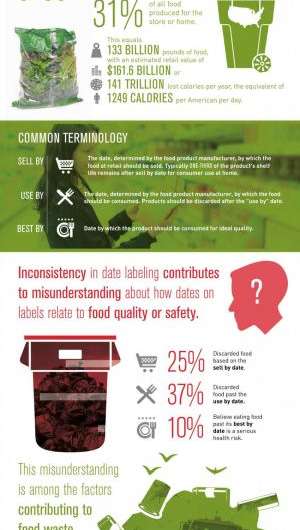Date labeling confusion contributes to food waste
Date labeling variations on food products contribute to confusion and misunderstanding in the marketplace regarding how the dates on labels relate to food quality and safety, according to a scientific review paper in the July issue of Comprehensive Reviews in Food Science and Food Safety. This confusion and misunderstanding along with different regulatory date labeling frameworks, may detract from limited regulatory resources, cause financial loss, and contribute to significant food waste.
In the United States, the United States Department of Agriculture Economic Research Service (USDA/ERS) estimated that in 2010 about 133 billion pounds of food, which is about a third (31 percent) of the 430 billion pounds of edible food available at the retail and consumer levels, was not eaten as a result of being wasted (Buzby and others 2014). This loss had an estimated $161.6 billion in retail value and 141 trillion calories per year (or 1249 calories per American per day).
The Food and Agriculture Organization of the United Nations estimates that the amount of food loss and waste on a global scale is about one-third of food produced for human consumption, which translates into 1.3 billion metric tons of food produced for human consumption (FAO 2011).
The authors of the scientific review call for collaboration to address the challenges that food manufacturers, retailers, government officials, consumers and other stakeholders face as a result of the current date labeling situation. More specifically, they called for the following actions:

- Alignment among the food industry to develop a more consistent or single best practices date-marking system which takes into consideration on-package storage instructions. Uniformity is the first step to better inform and educate the consumer, and provide clear, simple direction on food quality and safety.
- Revisit this issue among regulatory agencies. In some cases, U.S. and international regulators have devoted excessive resources and inspectional focus on food quality date labeling at the retail level. Quality-based date labeling is not a critical food safety issue; thus, resources could be shifted to ensure that regulatory efforts are focused around more significant health and safety risks rather than on labeling concerns that have to do with food quality.
- Provide clear, simple consumer direction on food quality and safety. Data show that many consumers do not understand the difference between a "use by" and "best before" date, and the extent of food waste occurring within the household. Food waste behavior can be changed through education about the meaning of date labeling, the importance of temperature control and limited shelf life for some food products, food storage guidance, and safe handling methods.
- Conduct more research to evaluate and further develop indicator technologies (e.g., time and temperature monitoring devices) that could provide information relating to food product quality or safety. Technology enhancement and improvements along the supply chain to monitor temperature and storage information could help better gauge true shelf life and reduce food waste, particularly with respect to fresh produce.
More information: Read the full scientific review paper here.
Provided by Institute of Food Technologists

















